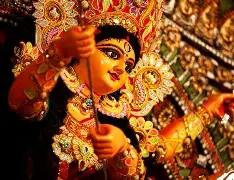Navratri — the nine-day festival honouring Goddess Durga — is as much a season of devotion as it is of food. Across India, families, temples and community pandals prepare bhog (prasadam) every day to offer to the Navadurga, then share the sanctified meal with devotees. In 2025, Shardiya Navratri falls from September 22 to October 1, with Vijayadashami (Dussehra) on October 2 — and the cooking pots are ready.
This article explains the traditional bhog associated with each of the nine days, the ritual and cultural meaning of those offerings, regional variations, and practical tips for devotees preparing bhog at home or in community kitchens. Wherever possible, the descriptions below rely on reported, verifiable guidance from festival coverage and cultural calendars.
Why bhog matters: food as devotion and community
Bhog is more than food — it is an offering, an act of gratitude and an instrument of shared blessing. In Durga worship, bhog is first offered to the Goddess and then consumed by priests and devotees; this practice symbolizes equality, generosity and the spiritual sharing of bounty. Large pandals and home altars alike favor simple, sattvic preparations (such as khichdi, labra and payesh) that align with fasting rules and religious norms.
Different regions and families follow slightly different bhog traditions. Below is a commonly reported, pan-Indian list linking each day’s avatar with typical offerings reported by multiple Indian media and ritual guides for Navratri 2025. These are representative suggestions rather than prescriptive rules — local custom may vary.
Day 1 — Maa Shailputri (Shailaputri)
Typical bhog: Pure ghee preparations, milk-based sweets or laddoo made with ghee. The focus is on purity and strength.
Day 2 — Maa Brahmacharini
Typical bhog: Fruits, sugar, and light sattvic items that honour asceticism and penance. Simple offerings reflect the goddess’s austere form.
Day 3 — Maa Chandraghanta
Typical bhog: Sweet preparations and rice-based dishes; devotees prefer calming, nourishing items to invoke protection and courage.
Day 4 — Maa Kushmanda
Typical bhog: Pumpkin dishes, sweet puris (with jaggery), and energy-rich foods to celebrate the creative force. Pumpkin and jaggery feature in several regional menus.
Day 5 — Maa Skandamata
Typical bhog: Dairy items such as milk, paneer or milk-based sweets and seasonal fruits — symbolizing the motherly aspect and nourishment.
Day 6 — Maa Katyayani
Typical bhog: Spiced vegetable preparations (sattvic), kheer or other sweets that mark the warrior aspect of the goddess.
Day 7 — Maa Kalaratri (Kaalratri)
Typical bhog: Jagerry (gur)-based sweets and warm, grounding foods such as gud preparations, believed to invoke protection and dispel fear.
Day 8 — Maa Mahagauri
Typical bhog: Coconut-based sweets, white offerings and simple, pure foods that symbolise purity and tranquillity.
Day 9 — Maa Siddhidatri
Typical bhog: A celebratory assortment — payesh/ kheer, sweets (like malpua or sandesh), fruits and savouries — marking the culmination and blessings for accomplishment.
Note: Several contemporary news features and ritual guides present similar day-wise bhog lists; they also highlight that trade, regional practice and availability influence the final menu. Devotees often adapt recipes to fasting restrictions or local tastes.
Common bhog items across India — what you’ll frequently see
While day-wise detail differs by custom, there are recurring core dishes and categories that appear in Durga bhog across states:
- Khichdi (rice and lentils): simple, sattvic and widely used in Durga Puja/ Navratri bhog.
- Labra / mixed vegetables: a nutritious, mixed-veg curry common in Bengal and many kitchens.
- Sweets: payesh/kheer, malpua, laddoo, sandesh, rasgulla — offerings of sweetness to the goddess and devotees.
- Fried items (in some regions): beguni (batter-fried brinjal), pakoras — usually offered in Durga Puja bhog in Bengal and nearby areas.
Fasting rules & dietary dos and don’ts
Navratri fasting practices shape bhog menus. Many devotees avoid onion, garlic, grains (wheat/rice in some sects), and non-vegetarian food during the nine days, favouring vata– or vrat-friendly ingredients such as buckwheat (kuttu), water chestnut flour (singhare ka atta), sabudana, potatoes, fruits, milk and dairy. Media coverage ahead of Navratri 2025 summarised common fasting guidelines used by devotees.
Regional variations — a reminder that “Navratri bhog” is many things
India’s diversity means bhog can vary widely: West Bengal’s Durga Puja feasts centre on khichdi, labra, beguni and payesh; Gujarati households may emphasize farsan and mithai; South Indian homes might offer curd rice, sakkarai pongal or payasam; Maharashtrian and North Indian bhogs incorporate their own local fasting dishes. Readers should treat the day-wise items above as a helpful framework rather than a strict rule.
Practical tips for preparing bhog at home or in community kitchens
- Plan a simple core menu. Choose 2–3 staple items (khichdi, a vegetable, one sweet) that can scale for family or community servings.
- Respect fasting rules. Confirm whether your household follows strict vrat rules (no onion/garlic, no grains) and pick recipes accordingly.
- Hygiene & distribution. If you distribute bhog to neighbours or a pandal, maintain food-safety standards — hot food should stay hot; use covered containers; enforce clean serving practices. (Common best practice drawn from community kitchen guidance.)
- Label offers for allergens. With crowds and community service, simple labels (contains milk, nuts, etc.) help prevent reactions.
- Use local produce and seasonal items. Pumpkin, jaggery, seasonal fruits and milk are traditional and widely available.
Cultural & social impact
Bhog rituals during Navratri reinforce community bonds — shared food removes social distance and fosters collective celebration. Modern pandals and temples frequently scale bhog distribution to feed thousands, combining religious duty with social welfare. Recent festival features emphasise that bhog continues to be a vehicle of cultural continuity in an era of urban migration and diaspora celebrations.
Recipes & further reading
For readers who want to try making traditional bhog at home, several reputable outlets provide tested recipes for khichdi, malpua, payesh, labra and vrat-friendly dishes — see DNA India, NDTV Food and festival coverage in mainstream outlets for step-by-step guid
Bhog during Navratri blends devotion, dietary discipline and community sharing. Whether you follow a strict vrat menu or prepare a simple family bhog, the ritual ties the nine days together — nourishing both the body and the spirit. As the 2025 festival approaches, these day-wise offerings are practical touchpoints that help devotees align tradition, regional practice and personal devotion.
Also read:How the Latest IBPS Recruitment Drives Are Changing Opportunities for Rural Applicants

